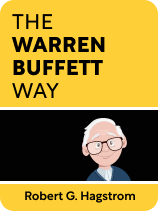

This article is an excerpt from the Shortform book guide to "The Warren Buffett Way" by Robert G. Hagstrom. Shortform has the world's best summaries and analyses of books you should be reading.
Like this article? Sign up for a free trial here.
How does Warren Buffett invest? What’s the best way to adopt his approach?
In The Warren Buffett Way, investment professional Robert G. Hagstrom outlines Warren Buffett’s investment strategies. Hagstrom explains why Buffett believes that focus investing is better than modern portfolio theory, and he shares some pitfalls to avoid as a focus investor.
Read on to learn how to manage your portfolio like Buffett and to find an exercise that will help you examine your investing habits.
Manage Your Portfolio Like Warren Buffett
Hagstrom discusses how Buffett chooses which individual companies to invest in, and then he shifts gears to explain how Buffett manages his broader investing portfolio. So, exactly how does Warren Buffett invest? First, we’ll examine the key tenets of focus investing, Buffett’s approach that emphasizes focusing on a select group of stocks. Then, we’ll discuss the psychological pitfalls associated with focus investing and how to avoid them as you manage your portfolio.
The Superiority of Focus Investing
According to Hagstrom, Buffett departs significantly from the mainstream when it comes to portfolio management. He writes that, while most investors diversify their portfolios broadly to minimize volatility, Buffett focuses on a select handful of stocks to maximize his chances of above-market returns.
To see the merits of focus investing, it’ll help to first discuss the main alternative: diversification. Hagstrom notes that investors traditionally prefer diversified portfolios because they supposedly minimize risk—after all, if you have 1,000 stocks represented in your portfolio and one lone stock takes a nosedive, it’s unlikely to cause a catastrophic loss. By contrast, if you only have five stocks in your portfolio, one plummeting stock could cause an outsized loss.
| How to Diversify Your Portfolio Outside of the Stock Market Although diversification is typically discussed in the context of stock market investing, experts note that investors can diversify their portfolios beyond the stock market. For example, you can invest in: • Bonds, which involve loaning money to governments or private corporations in exchange for a modest return down the road. • Gold, which is generally protected from the volatility of the stock market. • Real estate, which is simpler and can provide a lower-risk investment than many stocks. By pursuing these alternative investments, you can better protect yourself in the case of a stock-market crash which can devastate those who have only invested in stocks. For this reason, investing legend John C. Bogle (The Little Book of Common Sense Investing) recommends that even the most aggressive investors keep no more than 80% of their portfolio in stocks. |
However, Hagstrom points out that Buffett is opposed to diversification for one simple reason—it can only lead to mediocre results relative to the market’s average returns. After all, the more diversified your portfolio is, the more closely its returns will mirror those of the stock market.
Not content with mediocrity, Buffett instead prefers a portfolio consisting of around 10 stocks that he deems exceptional. To show that this approach is most likely to generate above-market returns, Hagstrom cites a statistical simulation showing how hypothetical portfolios of different sizes performed over time. This simulation included 3,000 portfolios of only 15 stocks—the focus group—3,000 portfolios of 50 stocks, 3,000 portfolios of 100 stocks, and 3,000 portfolios of 250 stocks. Hagstrom notes that, of the focus portfolios, over 25% beat the market over a sample 10-year period; by contrast, only 2% of the portfolios with 250 stocks beat the market over that same time span.
Admittedly, Hagstrom concedes that because smaller portfolios are more volatile—meaning they have greater swings in value—they’re also much more likely to deliver below-average returns. However, he suggests that investors can avoid this possibility through Buffett’s savvy stock selection, which he deems far less likely to yield subpar returns.
| Diversification and the Merits of “Mediocre” Returns Though Hagstrom deems market-average returns mediocre when discussing the argument against diversification, it’s worth mentioning that the average investor already earns far below market-average returns. Indeed, expert analysis reveals that between 2000 and 2020, the average equity fund investor earned only 4.25% annually, while the S&P 500 earned 6.06%. Experts contend that investors earn below-market returns for various reasons. For instance, they tend to buy stocks when the market is high and sell when it’s low, leading to worse returns than if they simply held their stocks indefinitely. But, according to Bogle, one particular reason stands out: Many investors invest in actively managed mutual funds with high portfolio turnover, generating inflated trading costs and fees paid to those mutual funds and reducing investors’ returns. Consequently, Bogle recommends investing in index funds—funds that track an underlying index, yielding a diversified portfolio—to avoid these costs and enjoy market-average returns. In so doing, you’ll earn more than the vast majority of investors, even though you’ll only be earning the “market average.” So, for investors not yet confident enough to embrace Buffett’s focus investing, index funds are a viable alternative. |
Focus Investing and Modern Portfolio Theory
It bears mentioning that Buffett’s focus investing is diametrically opposed to the orthodox investing approach in academia–modern portfolio theory. In particular, Buffett rejects portfolio theory’s understanding of market efficiency and risk.
View #1: The Efficient Market Hypothesis
As Hagstrom relates, the cornerstone of the modern portfolio is the efficient market hypothesis (EMH)–the thesis that stock market prices perfectly reflect all available information about a given company, meaning all stocks are fairly priced. Consequently, proponents of EMH reason that investing ultimately boils down to luck since no amount of analysis will reveal insights that aren’t already baked into a company’s stock price.
Buffett rejects EMH, arguing that many investors—himself included—have used focus investing to generate above-market returns, and these returns aren’t just the product of luck. These investors, including Charlie Munger, Bill Ruane, and Lou Simpson, all used similar approaches to investing, centered around Graham’s strategy of finding undervalued stocks. And, rather than claiming that the success of this shared approach is a coincidence, Buffett finds it much more believable that EMH is simply mistaken.
View #2: Defining Risk as Volatility
Because modern portfolio theory holds that investing boils down to luck, it defines risk as volatility, since the more volatile your portfolio is, the more likely that you’ll lose money. Buffett, however, has a different conception of risk when investing: According to Hagstrom, he defines it as the possibility that you’ll be left with less purchasing power than you began with.
Hagstrom explains that, for this reason, Buffett emphasizes the importance of patience to mitigate risk. After all, if you’ve selected an exceptional stock to invest in, it’s highly likely that its stock price will rise given enough time. By contrast, even if you invest in an exceptional company, your risk will be high if you only hold it for one week since the stock market experiences short-term ebbs and flows.
Psychological Pitfalls to Avoid
Because focus investing leads to greater volatility, it can make you more prone to psychological pitfalls. Hagstrom argues that, to maximize success, focus investors must avoid excessive confidence, overreaction bias, and myopic loss aversion.
Pitfall #1: Excessive Confidence
First, Hagstrom argues that investors need to avoid having excessive confidence, which leads directly to shoddy investment decisions. This overconfidence bias, he notes, is a general problem; for example, a large majority of people consider themselves above-average drivers, even though only half of all drivers are above-average. When it comes to investing in particular, overconfident investors are liable to invest too heavily in stocks they deem exceptional, leaving them susceptible to large losses if these stocks dip.
(Shortform note: Though Hagstrom cautions against excessive confidence, he doesn’t offer specific actionables for avoiding it. To that end, experts list various strategies for dealing with overconfidence. For example, they recommend specifically asking others to share their views so that you’re exposed to opinions that differ from your own. In a similar vein, they advise seeking out disconfirming information–information that calls your own beliefs into question–so that you don’t hold your views blindly but rather are aware of the counterarguments.)
Pitfall #2: Overreaction Bias
Next, Hagstrom argues that investors must overcome overreaction bias because it leads them to make imprudent, snap decisions on the basis of recent events alone. Put simply, overreaction bias refers to our tendency to assign too much weight to recently discovered information in our decision-making process.
For example, seniors in high school might decide which college to attend on the basis of a recent shift in college rankings, even though this recent shift is ultimately a small data point. In the case of investing, Hagstrom writes that overreaction bias can lead investors to overemphasize short-term developments—like dips in the stock market, or recent earnings reports—instead of focusing on companies’ long-term prospects. Because savvy investing depends on these long-term prospects, overreaction can lead to suboptimal decisions.
(Shortform note: Overreaction bias is often intertwined with negativity bias–our tendency to weigh negative information far more heavily than positive information when making decisions. In the case of investing, this means that investors are more likely to overreact when presented with negative information, such as a disappointing earnings report, rather than positive information, such as a promising earnings report.)
Pitfall #3: Myopic Loss Aversion
Finally, Hagstrom writes that myopic loss aversion is the greatest psychological obstacle to investors’ success. As he relates, myopic loss aversion is the combination of loss aversion—the fact that humans are significantly more sensitive to losses than similar-sized gains—with investors’ tendency to chronically check their portfolios. In other words, it refers to an aversion to short-term losses in particular.
Hagstrom suggests that because the stock market experiences inevitable ebbs and flows, myopic loss aversion can deter us from staying the course and investing for the long term, leading us to sell whenever the market dips. Thus, although this approach might save us from short-term losses, it prevents us from reaping the massive long-term gains that investors like Buffett are after.
(Shortform note: It’s natural to think that while myopic loss aversion can harm the average investor’s returns, professionals are less susceptible to it. Yet, one influential analysis suggests that compared to a control group of undergraduate students, professional traders are actually more vulnerable to myopic loss aversion. In turn, these professionals are liable to make irrational decisions that harm their returns in the long run.)
Exercise: Evaluate Your Investing Habits
Buffett’s preferred approach—focus investing—runs counter to traditional investing advice, which emphasizes diversification and discourages investors from analyzing companies themselves. In this exercise, reflect on your investing practices to find areas where you could implement Buffett’s advice.
- Buffett’s preferred portfolio includes around 10 stocks. How many stocks have you invested in, and what was your rationale for choosing these stocks?
- Of the stocks in your portfolio, choose one. How highly would you rate this company from a quantitative standpoint (that is, in terms of the company’s market value and finances)? For example, this could involve calculating the company’s ROE or finding its profit margins.
- How highly would you rate this company from a qualitative standpoint (that is, in terms of the company’s management and business model)? For instance, this might involve assessing the management’s transparency in past letters to shareholders and the simplicity of its business model.
- In light of your previous answers, do you think this company is a promising investment? Why or why not?

———End of Preview———
Like what you just read? Read the rest of the world's best book summary and analysis of Robert G. Hagstrom's "The Warren Buffett Way" at Shortform.
Here's what you'll find in our full The Warren Buffett Way summary:
- How to invest like Warren Buffett and earn above-market returns
- How to assess companies to identify which ones to invest in
- Tips for managing your portfolio and avoiding psychological mistakes






